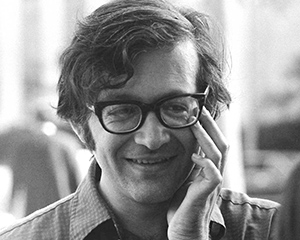PASSING OF DIEGO CESARSKY, DEPUTY DIRECTOR OF THE IAP IN 1982-1989
 Credit: Bob Rood †
Credit: Bob Rood †
Diego A. Cesarsky (1941 - 2021) was deputy director of the IAP from 1982 to 1989, in perfect complementarity with the director Jean Audouze. He contributed greatly to making the IAP an astrophysics laboratory of excellence with an international reputation.
Diego Cesarsky began his postgraduate studies at the University of Buenos Aires (Argentina), where he met Catherine Cesarsky (née Gattegno), to whom he married in 1965, before they both went on to prepare their PhDs in astrophysics at Harvard University (Cambridge, Massachussets, USA) from 1966. Diego's thesis, directed by Leo Goldberg, was on the recombination lines emanating from HI and HII regions of the interstellar medium. In particular, it provided the first detection of recombination lines emitted by atoms heavier than hydrogen, such as carbon. In 1971, Diego and Catherine both became post-doctoral fellows at the Department of Astronomy at Caltech in Pasadena (California, USA). Diego, as a radio astronomer, made numerous observations at Owens Valley Radio Observatory (California) and published the first detection of the deuterium line in absorption towards the galactic centre.
After their American period, Diego and Catherine decided to pursue their careers in France in 1974. While Catherine joined the Service d'Électronique Physique de Saclay, then directed by Jacques Labeyrie and Lydie Koch, Diego became a member of DERAD, the radio astronomy department at Meudon, and was particularly involved in instrumentation at the Nançay radioastronomy station. He also carried out observations in optical astronomy at the European Southern Observatory (ESO). In 1977, for example, he discovered the irregular dwarf galaxy Sagittarius, located 4.2 million light years away.
In 1982, at the beginning of his second term as director of the IAP, Jean Audouze invited Diego to become deputy director of the IAP following Jean-Loup Puget. From 1982 to 1989, Jean and Diego ran the IAP together in perfect friendship. Diego contributed greatly to making the IAP an astrophysics laboratory of excellence and international reputation, by equipping it, among other things, with the best computer and computing resources of the time and by introducing modern methods of data reduction.
At the end of his mandate as deputy director of the IAP, Diego joined the Institut d'Astrophysique Spatiale (IAS) in Orsay. He participated in the development of the ISOCAM camera for the ISO satellite, and was part of the first team to collect ISOCAM data at Villafranca (Spain) and to perform the checks and tuning of the instrument. He then made observations and published articles on various subjects, including his favourite subject, the spectro-imaging of interstellar gas. From 1999 to 2009, during and beyond Catherine's term as ESO Director General, he joined the Max Planck Institute for Extraterrestrial Physics in Garching (Germany). In line with his work on ISOCAM, he participated in the development of the PACS instrument for the Herschel satellite.
The French astronomical community is therefore in mourning and deplores the death of Diego, a colleague with a particularly endearing personality, who accomplished a considerable amount of work in a very discreet way, not only in the field of radio-astronomical research, but also in the service of everyone in the various functions he was willing to assume with efficiency.
Condensed tributes to Diego Cesarsky, mainly when he was Deputy Director of the IAP from 1982 to 1989
What is quite remarkable in the thirty or so messages of tribute and friendly support received by Catherine following Diego's death, and relating to the IAP, is the convergence, even the similarity, of the reactions and judgements of their authors, most of whom were present at the IAP at the same time as he was, either as a doctoral student, senior researcher or team leader.
In all these messages there is a reference to Diego's bonhomie (“I liked Diego very much and his kind smile was almost always on his lips”). Diego is described as a particularly friendly and caring colleague. The different messages mention his natural humour, his warm welcome, his kindness, his listening and his altruism.
Of course, most correspondents are grateful to Diego for the concrete help he gave them in solving their computer problems. Diego always did so with generosity and good mood. For Diego left as a legacy not only to the IAP, but also to the Observatoire de Paris, computer means that were particularly efficient at the time he designed them.
With all his human qualities and skills, which he put at the service of everyone, Diego made the 1982-1989 period in the history of the IAP particularly happy and productive.
Writing: Jean Audouze, François Bouchet, Catherine Cesarsky, Valérie de Lapparent
Layout: Jean Mouette
May 2021
